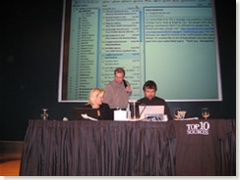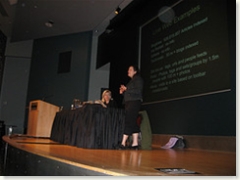 RSS and Feeds: Monitoring the Blogosphere and the Buzz with Dave Taylor, Mary Hodder and Halley Suitt.
RSS and Feeds: Monitoring the Blogosphere and the Buzz with Dave Taylor, Mary Hodder and Halley Suitt.
Dave Taylor led off. He posed the question, “How do you find bloggers who are writing about your space?” You have a choice of tools, including: google blogsearch and technorati.
Technorati ranks bloggers by authority – the greater number of inbound links from other blogs that they receive, the higher their authority.
With Technorati, it is possible to “subscribe” to a search. This will deliver new entries relating to the search term directly to your browser as they are posted.
An RSS aggregator such as newsgator online, bloglines or google reader is an absolutely essential tool to keep up with your RSS feeds.
 Mary Hodder spoke about the difference between how Google searches and show results and the way that a blog-specific search enigne like technorati searches and displays results.
Mary Hodder spoke about the difference between how Google searches and show results and the way that a blog-specific search enigne like technorati searches and displays results.
Google is best at measuring the “static web;” technorati is best for the “live web.”
Google is best for static web pages – pages that do not change regularly. Bloggers change their content frequently and a search engine is required that specializes in current information which may not show up immediately on the google search engine.
It is also possible to track images uploaded on flickr by tags.
Other possible metrics include the number of comments (some bloggers may not have many inbound links, but may have many comments. ) If you only take inbound links without looking at comments, you may fail to see the real depth of the conversation at the site.
Frequency of blogging on a topic is another dimension to consider. A blogger who writes frequently on a particular topic may not have the same authority on another subject that they blog on only once or twice.
Mary sees a difference between influence and real authority. Authority happens on a person by person basis. Each of us assigns authority. However, technorati will rank people high in “authority” – which really means they are high in popularity.
Halley Suitt showed several examples of Web sites that display RSS feeds differently. Some display them with XML chiclets. Some use the new RSS standard icon. Others have text links to the RSS feeds. For RSS to become mainstream, RSS must be displayed in a more standardized and prominent way.
